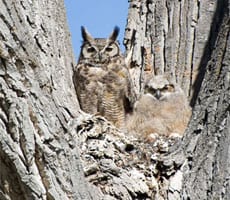Citizen science offers cost-effective tools for bird monitoring, education, and outreach among scientists, policy-makers, and private citizens. Besides providing valuable data for bird conservation, volunteer citizen scientists enhance their knowledge of birds, as well as their conservation involvement.
One excellent example of this is a project in Tucson, Arizona. Dr. Bill Mannan and his graduate students in the School of Natural Resources and the Environment at the University of Arizona have been studying Cooper’s, Harris’s, and Red-tailed hawks, and Great Horned Owls in Tucson for over 20 years. The overall purpose of the work is to assess how these birds of prey fare in urban areas. The high abundance of food, water, and nest sites available to these birds in Tucson suggests that their populations should thrive. However, urban environments harbor dangers to these birds that can reduce survival and productivity. For example, nestling Cooper’s Hawks suffer from an urban-related disease called trichomoniasis, and adults fly into windows and may be hit by cars while hunting. The larger-bodied hawks and owls in Tucson (e.g., Harris’s and Red-tailed hawks, and Great Horned Owls) are susceptible to electrocution on the utility poles that distribute electricity to our homes and businesses.
Assessing whether bird populations are increasing, decreasing, or remaining stable requires information on the abundance of nests, and rates of productivity and survival. Researchers on Mannan’s project gather this information by monitoring nests to ascertain how many nestlings are produced, marking birds with leg bands to determine how long they live, and radio-tracking birds to find out where they spend their time in the urban environment.
The metropolitan area of Tucson is large and Great Horned Owl by George Gentry/USFWSsome of the species we study are very abundant. For example, there are likely over 200 breeding pairs of Cooper’s Hawks in the city. Finding and monitoring all of these nests, and keeping track of all marked birds, are overwhelming tasks. Over the years, Tucson residents have helped this research immeasurably by reporting locations of nests, incidents of hawks flying into windows, the whereabouts of color-marked hawks, and the utility poles that might have electrocuted a hawk or owl. Part of the success of this project is due to the assistance of these citizen scientists. Mannan plans to continue this work for several more years, and the continued support and involvement of citizen scientists will be invaluable. To learn more about this project or become involved, contact Dr. Mannan at 520-621-7283.

